10+SAMPLE Horse Agreement
-
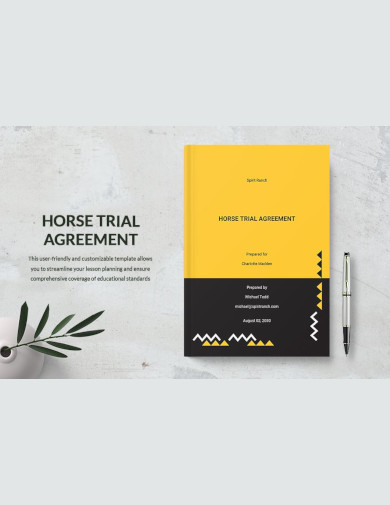
Horse Trial Agreement Template
download now -
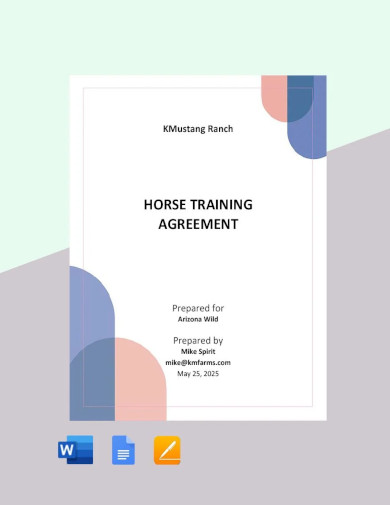
Horse Training Agreement Template
download now -
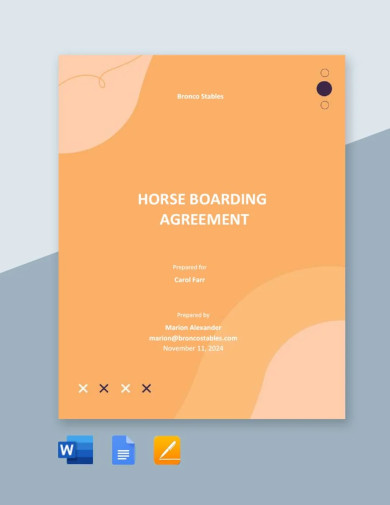
Horse Boarding Agreement Template
download now -
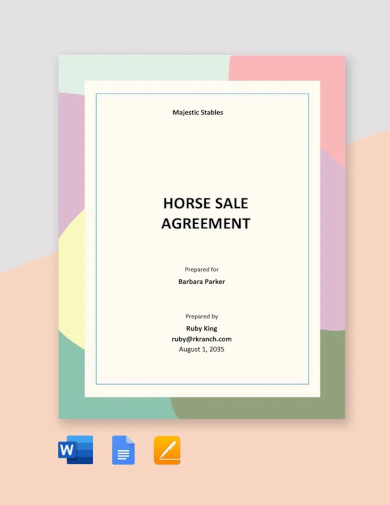
Horse Sale Agreement Template
download now -
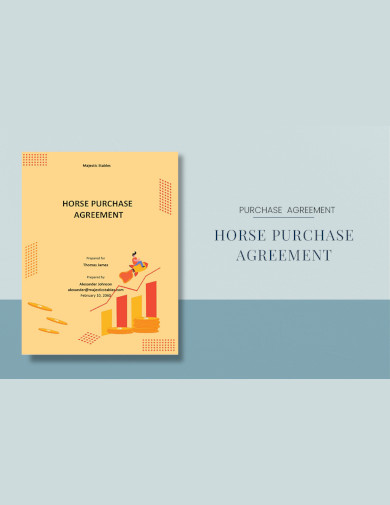
Horse Purchase Agreement Template
download now -
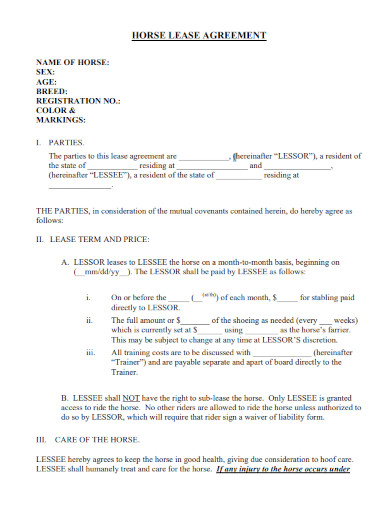
Sample Horse Lease Agreement
download now -
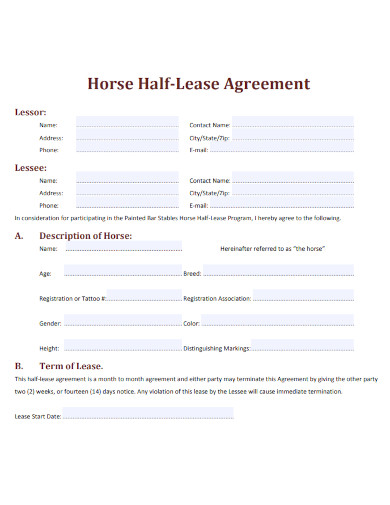
Horse Half-Lease Agreement
download now -

Part Time Horse Lease Agreement
download now -
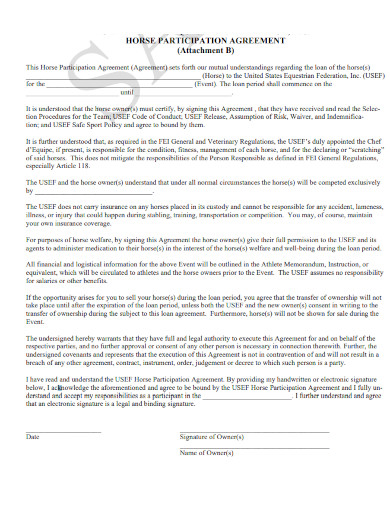
Horse Participation Agreement
download now -
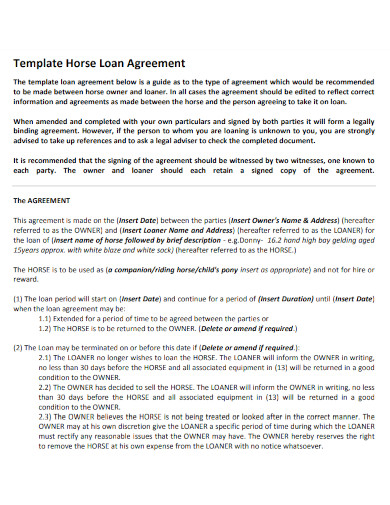
Horse Loan Agreement Template
download now -
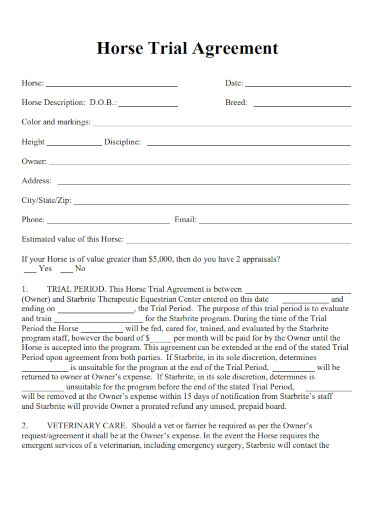
Sample Horse Trial Agreement
download now
What is a Horse Agreement?
A horse agreement, also known as an equine agreement, is a legally binding document that outlines the terms and conditions governing the relationship between parties involved in the ownership, care, and use of a horse. This comprehensive contract and agreements serves to prevent disputes, clarify responsibilities, and establish a clear understanding of the expectations between horse owners, caretakers, and any other relevant parties.
Introduction:
A horse agreement is a vital tool for individuals engaged in equine activities, ranging from horse ownership to leasing, boarding, or any collaborative endeavor involving horses. This document plays a crucial role in preventing misunderstandings and legal disputes by clearly defining the rights, responsibilities, and expectations of each party involved.
Key Components:
1. Identification of Parties:
The agreement typically begins by identifying the parties entering into the contract. This includes the legal names and contact information of the horse owner, caretaker, and any other relevant individuals or entities.
2. Description of the Horse:
Precise details about the horse involved, such as its name, breed, color, markings, and any identifying features, are outlined to avoid confusion and ensure a clear reference.
3. Ownership Details:
If the agreement pertains to horse ownership, it specifies the transfer of ownership rights, including any conditions or stipulations related to the sale or transfer.
4. Care and Maintenance:
The sample document outlines the responsibilities of each party regarding the horse’s care, including feeding, veterinary care, grooming, exercise, and any specific health or dietary requirements.
5. Use and Riding:
In cases where the horse is intended for riding or specific activities, the agreement may include details about the permitted use, restrictions, and any safety measures to be followed.
6. Insurance and Liability:
To mitigate risks, the agreement addresses issues related to insurance coverage, liability for injuries or damages, and the steps to be taken in case of unforeseen circumstances.
7. Duration and Termination:
The agreement specifies the duration of the arrangement and the conditions under which either party can terminate the agreement. This may include notice periods and the resolution of any outstanding issues.
8. Dispute Resolution:
In the event of a disagreement, the agreement may include provisions for dispute resolution, such as mediation or arbitration, to avoid costly legal proceedings.
Why Would Someone Lease a Horse?
Leasing a horse offers several benefits for individuals who may not be ready for the full commitment and responsibilities of horse ownership. Here are some common reasons why someone might choose to lease a horse:
1. Financial Considerations:
Horse ownership involves significant expenses, including feed, veterinary care, farrier services, and boarding. Leasing allows individuals to enjoy the companionship of a horse without the upfront and ongoing financial burdens associated with ownership agreement.
2. Temporary Interest or Commitment:
Some individuals may have a temporary interest in horse riding or horse-related activities. Leasing provides the flexibility to engage in these activities without the long-term commitment of owning a horse.
3. Skill Development:
For riders looking to improve their equestrian skills, leasing a horse can offer valuable hands-on experience. It provides an opportunity to work with different horses, enhancing riding abilities and gaining confidence in handling equine behavior.
4. Testing Compatibility:
Leasing allows individuals to test their compatibility with a specific horse before committing to ownership. This trial period helps assess whether the horse’s temperament, riding style, and overall needs align with the lessee’s preferences and lifestyle.
5. Limited Time Availability:
Individuals with busy schedules or other time constraints may find it challenging to meet the daily care requirements of a horse. Leasing allows them to enjoy the benefits of horse companionship without the need for constant attention.
6. Access to Quality Horses:
Leasing provides access to well-trained and quality horses that the lessee might not be able to afford or acquire for ownership. This is particularly beneficial for riders who want to participate in specific riding disciplines or competitions.
7. Avoiding Long-Term Commitments:
Some individuals may be hesitant to commit to the long lifespan of a horse, which can be 20 years or more. Leasing provides a shorter-term commitment, giving individuals the freedom to reassess their situation as needed.
8. Flexibility in Riding Activities:
Leasing allows riders to engage in various riding activities, such as trail riding, jumping, or dressage, without the need to own multiple horses specialized in each discipline. This flexibility enhances the overall riding experience.
9. Transition to Ownership:
Leasing serves as a transitional step for individuals considering horse ownership in the future. It provides an opportunity to learn about horse care, responsibilities, and costs before making a long-term commitment.
How do you Break a Horse Lease?
Breaking a horse lease involves terminating the agreement before the agreed-upon end date. The process typically depends on the terms outlined in the lease agreement. Here are general steps to consider when breaking a horse lease:
1. Review the Lease Agreement:
Carefully review the terms and conditions specified in the horse lease agreement. Look for any clauses related to termination, notice periods, and conditions under which the lease can be ended.
2. Provide Notice:
If the lease agreement requires a notice period for termination, ensure that you provide the required notice to the horse owner. Common notice periods are 30 days, but this can vary based on the terms agreed upon in the lease.
3. Communicate Clearly:
Open communication is crucial. Inform the horse owner of your decision to break the lease and clearly explain the reasons for doing so. Discuss the situation amicably and try to find a mutually agreeable solution.
4. Follow Agreement Protocols:
Adhere to any specific protocols outlined in the lease agreement for terminating the lease. This may include returning the horse in a specified condition, settling any outstanding payments, or addressing other agreed-upon conditions.
5. Negotiate if Necessary:
If there are challenges or disputes related to breaking the lease, try to negotiate a resolution with the horse owner. This may involve discussing any financial obligations, finding a replacement lessee, or addressing concerns raised by the owner.
6. Document the Termination:
To protect both parties, document the termination of the lease in writing. Clearly state the date of termination, any agreed-upon conditions, and confirm that both parties understand and agree to the termination.
7. Resolve Financial Matters:
If there are financial aspects to consider, such as outstanding lease payments or other fees, work with the horse owner to settle these matters in accordance with the terms outlined in the lease agreement.
8. Coordinate the Horse’s Return:
Arrange for the return of the horse to the owner in accordance with the terms of the lease agreement. Ensure that the horse is returned in good health and meets any conditions specified in the agreement.
9. Finalize Agreement:
Once all aspects of the termination have been addressed and both parties are in agreement, consider signing a formal written agreement confirming the end of the lease. This can help prevent any future misunderstandings.
What are the Typical Terms of a Horse Lease?
The terms of a horse lease can vary based on the specific agreement reached between the horse owner (lessor) and the individual leasing the horse (lessee). However, here are some typical terms that are often included in a horse lease:
1. Duration of Lease:
Specifies the start and end dates of the lease period. It could be a short-term lease, such as a few months, or a longer-term arrangement, potentially spanning years.
2. Permitted Uses:
Outlines the activities the lessee is allowed to engage in with the horse, such as riding, training, or participating in specific equestrian disciplines. Some leases may have restrictions on certain activities.
3. Responsibilities for Care:
Details the daily care responsibilities of the lessee, including feeding, grooming, exercising, and general well-being of the horse. It may also specify who is responsible for veterinary care.
4. Insurance Requirements:
Specifies the insurance coverage required for the horse. This may include mortality insurance, liability insurance, or other types of coverage. Both parties’ responsibilities regarding insurance are outlined.
5. Lease Payments or Fees:
Outlines any financial arrangements, including lease payments or fees. The amount, frequency, and method of payment are typically specified in the agreement.
6. Conditions for Termination:
Describes the conditions under which either party can terminate the lease. This may include a notice period, specific events, or mutual agreement between the lessor and lessee.
7. Return Conditions:
Details the expectations for the return of the horse at the end of the lease period. This includes the condition in which the horse should be returned and any inspection procedures.
8. Alterations or Modifications:
Addresses whether the lessee is allowed to make any alterations or modifications to the horse, such as changes in shoeing, veterinary procedures, or dietary adjustments.
9. Liability Considerations:
Defines the responsibilities and liabilities of both parties in case of injury or damage related to the horse. This may include indemnification clauses and procedures for addressing disputes.
10. Renewal Terms:
Specifies whether the lease can be renewed for an additional term and outlines the process for renewal, including any adjustments to the terms.
11. Use of Facilities:
If the horse is kept at a specific facility, the lease may include terms related to the use of that facility, such as stable rules, access to arenas, and other amenities.
12, Notices:
Outlines how and when notices related to the lease should be provided, including any changes to contact information or other relevant details.
How Long does a Horse Lease Typically Last?
The duration of a horse lease can vary based on mutual agreement. It may range from a few months to several years. Some leases are short-term, allowing lessees to assess compatibility with the horse, while others may be longer for ongoing riding or competitive purposes.
What Responsibilities does a Lessee Have in a Horse Lease?
Lessees are typically responsible for the day-to-day care of the horse, including feeding, grooming, veterinary care, and exercise. The specific responsibilities are outlined in the lease agreement and may vary based on the terms negotiated.
